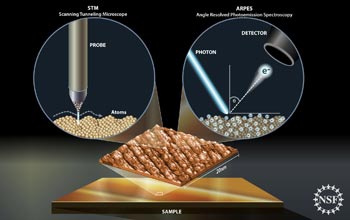Multimedia Gallery
Researchers use two techniques to understand high-temperature superconducting materials.
Using both scanning tunneling microscopy (STM) and angle-resolved photo-electron spectroscopy (ARPES) gives researchers a more complete understanding of high-temperature superconducting materials. STM can show actual atoms on the material's surface. ARPES uses the photoelectric effect by aiming a beam of light (photons) at the material's surface. The photons excite atoms in the material, causing them to eject electrons, which are then captured by a detector. The momentum (speed and direction) of the ejected electrons gives researchers information about the momentum of the electrons inside the material.
Credit: Nicolle Rager Fuller, National Science Foundation
Images credited to the National Science Foundation, a federal agency, are in the public domain. The images were created by employees of the United States Government as part of their official duties or prepared by contractors as "works for hire" for NSF. You may freely use NSF-credited images and, at your discretion, credit NSF with a "Courtesy: National Science Foundation" notation.
Additional information about general usage can be found in Conditions.
Also Available:
Download the high-resolution JPG version of the image. (250 KB)
Use your mouse to right-click (Mac users may need to Ctrl-click) the link above and choose the option that will save the file or target to your computer.
Related story: Exploring High-temperature Superconductivity and the Pseudogap



